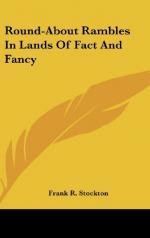Dr. Ebrard, who wrote a book about ants and their habits, tells a story of a little black ant who was building an arch at the foundation of a new ant-hill. It was necessary to have some means of supporting this arch, which was made of wet mud, until the key-stone should be put in and all made secure. The ant might have put up a couple of props, but this is not their habit in building. Their laws say nothing about props. But the arch must be supported, and so Mr. Ant thought that it would be a good idea to bend down a tall stalk of wheat which grew near the hill, and make it support the arch until it was finished. This he did by carrying bits of wet mud up to the end of the stalk until he had piled and stuck so much upon it that the heavy top bent over. But, as this was not yet low enough, and more mud could not be put on the slender stem without danger of breaking it, the ant crammed mud in between the stalk at its root and the other stalks, so that it was forced over still more. Then he used the lowered end to support his arch!
[Illustration]
Some other ants once found a cockchafer’s wing, which they thought would be a capital thing to dry for winter, and they endeavored to get it into the entrance of their hill. But it was too big. So they drew it out and made the hole larger. Then they tried again, but the wing was still too wide. They turned it and made several efforts to get it in sideways, and upside down, but it was impossible; so they lifted it away, and again enlarged the hole. But the wing would not yet go in. Without losing patience, they once more went to work, and, after having labored for three hours and a half, they at last had the pleasure of seeing their dried wing safely pulled into their store-room.
[Illustration]
Then, there are spiders. They frequently show the greatest skill and cunning in the construction of their webs and the capture of their prey, and naturalists say that the spider has a very well developed brain. They must certainly have a geometrical talent, or they could not arrange their webs with such regularity and scientific accuracy. Some spiders will throw their webs across streams that are quite wide.
Now, to do this, they must show themselves to be engineers of no small ability. Sometimes they fasten one end of a thread to a twig on one side of the stream, and, hanging on the other end, swing over until they can land on the other side. But this is not always possible, for they cannot, in some places, get a chance for a fair swing. In such a case, they often wait until the wind is blowing across the stream from the side on which they are, and, weaving a long line, they let it out until the wind carries it over the stream, and it catches in the bushes or grass on the other side. Of course, after one thread is over, the spider can easily run backward and forward on it, and carry over all the rest of his lines.
[Illustration]




